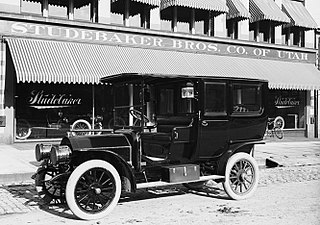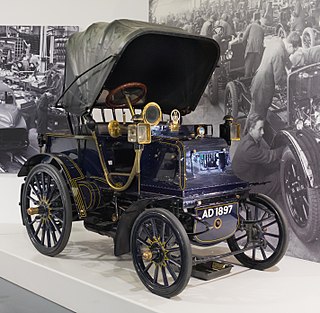
Supermini is a British car classification or vehicle size class for a small car, usually in a hatchback body style. It an equivalent of the European B-segment or American subcompact categories.

The PSA EW/DW engine is a family of straight-4 petrol and diesel engines manufactured by the PSA Group for use in their Peugeot and Citroën automobiles. The EW/DW family was introduced in 1998 as a replacement for the XU engine

Executive car is a British term for a large car which is equivalent to the European E-segment classification. Executive cars are larger than compact executive cars, and smaller than luxury saloons / full-size sedans.

The Peugeot Type 3 was an early French automobile; it was Peugeot's first model to be produced in significant numbers. It was their second car with an internal combustion engine.
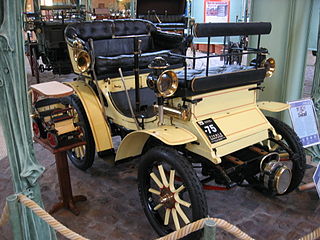
The Peugeot Type 26 was produced from 1899 to 1902 by Peugeot. It was larger than the mainstream Peugeot range, available as a four-seater. But the Type 26 still used the traditional rear-engined layout and chain drive mechanism of Peugeot's earliest cars. By the time it went out of production in 1902, this layout had been rendered obsolete by the introduction of rotating steel drive shaft and front-engine configuration of the Peugeot Type 48. A total of 419 Type 26s were produced.

The Peugeot Type 163 and associated models were produced from 1919 to 1924 by Peugeot. The car's engine placed it in the 10HP class.

The Peugeot Type 175 was a fairly large sports car from Peugeot produced in 1923 and 1924. This model was produced at the factory in Audincourt. The OHV engine, of the LA5 range, displaced 3.0 L and has a 4 speed gearbox. Only available with the "torpedo sport" or "torpedo grand sport" body at the price of 38000 old Francs. Colours: bleu, grey, green or red with black wings and chassis. Body was made of wooden frame with steel, as the bonnet was made of aluminium and a sloping nickel plated window. Bleriot headlights and a 12V SEV magneto and starter were fitted. In 1924, H. Petit won in this sports car, the 1100 km race Paris-Nice, in the category 3 litres. The "Paris Nice" Peugeot 175 Torpedo Grand Sport

The Peugeot Type 5 was a small car by Peugeot, produced from 1893 to 1896. Mechanically, little was changed from the Peugeot Type 3. The engine and most of the mechanical parts were unchanged, but the car was shorter, lighter, and correspondingly made more of its 2 horsepower. However, against larger models from Peugeot, this car did not fare well. A total of 14 were sold.
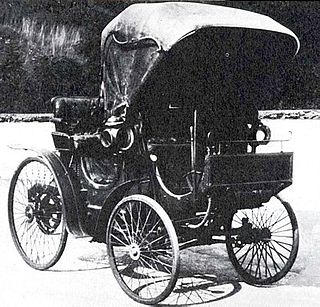
The Peugeot Type 6 was the ordinally last Peugeot vehicle to carry over the tired 2-hp 565 cc V-twin from the earliest Peugeot models. It was larger than the Type 5 and offered for 1894 only. A mere 7 units were built and sold, of which one survives in Louwman's museum in the Netherlands.
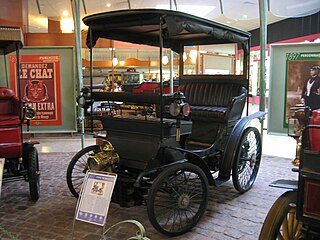
The Peugeot Type 16 was a mid-size family car produced by French automaker Peugeot from 1897 to 1900. The flat-twin engine was of the same series produced in the contemporaneous Peugeot Type 15, though the engine in the heavier Type 16 was enlarged to 2.4 L. During the production run, the Type 16 was joined in its class by the smaller Peugeot Type 17, the similar Type 19, and the larger Type 32. A total of 87 Type 16s were built.
The Peugeot Type 66 was the first large car from French automaker Peugeot, as well as the first vehicle from that manufacturer to have four cylinders. Most were made as closed-top limousines. The engine displaced 5.0 L and produced 25 horsepower (19 kW), which was sufficient to carry the car to a top speed of 87 kilometres per hour (54 mph). Production ran throughout 1904 and a total of 20 were built.

The Peugeot Type 174, also known at the time and normally advertised simply according to its fiscal horse power as the Peugeot 18HP, was a large, powerful sedan made by Peugeot from 1923 to 1926. The Type 174 S was made until 1926. The engine displaced 3828 cc, large and low-revving for a four-cylinder engine, and produced a not inconsiderable 85 horsepower. The sport version sold 208 examples compared to 810 for the standard version.

The Peugeot Type 177 B was a mid-range car produced between 1924 and 1929 by the French auto-maker Peugeot. With a fiscal horsepower of 10 CV, and a wheel base of 2670 mm, it competed in the same sector as the Citroën B2 and Renault KZ.

The Peugeot Type 183 was a 2-litre six cylinder car produced between 1927 and 1931 by the French auto-maker Peugeot at their Audincourt plant. It was first exhibited at the Paris Motor Show in 1927, but cars only became available for sale in 1928.

The Peugeot Type 156 was a large car announced in 1920 and produced between 1921 and 1923 by the French auto-maker Peugeot at their Sochaux plant. It was Peugeot’s first large car since before the First World War and its arrival recalled the Peugeot Type 135 which had ceased production in 1913. However, the 156 was larger and more powerful.

The Peugeot Type 184 was a large car produced between 1928 and 1929 by the French auto-maker Peugeot at their Issy-les-Moulineaux plant. It represented an attempt to widen the range further upmarket, being larger than the Peugeot Type 174 which had itself been significantly upgraded in 1926. Its opulence was nevertheless out of touch with the market place at the time and the model was taken out of production, without a direct replacement, after less than two years.
The Peugeot Type 173 is a mid-range car produced between 1922 and 1925 by the French auto-maker Peugeot at their Beaulieu plant. It replaced the company’s celebrated Type 163 which itself had done much to revive the company’s fortunes in the difficult years directly following the First World War.
The Peugeot Type 126 is an early motor car produced in 1910 by the French auto-maker Peugeot at their Audincourt plant. 350 were produced.
The Peugeot Type 14 is an early motor car produced between 1897 and 1898 by the French auto-maker Peugeot at their Audincourt plant. First presented in public at the end of 1896 the Type 14 was the first new car introduction after Armand Peugeot’s new company “Automobiles Peugeot” had been registered, following formalisation of Armand’s split from the then principal Peugeot business.


